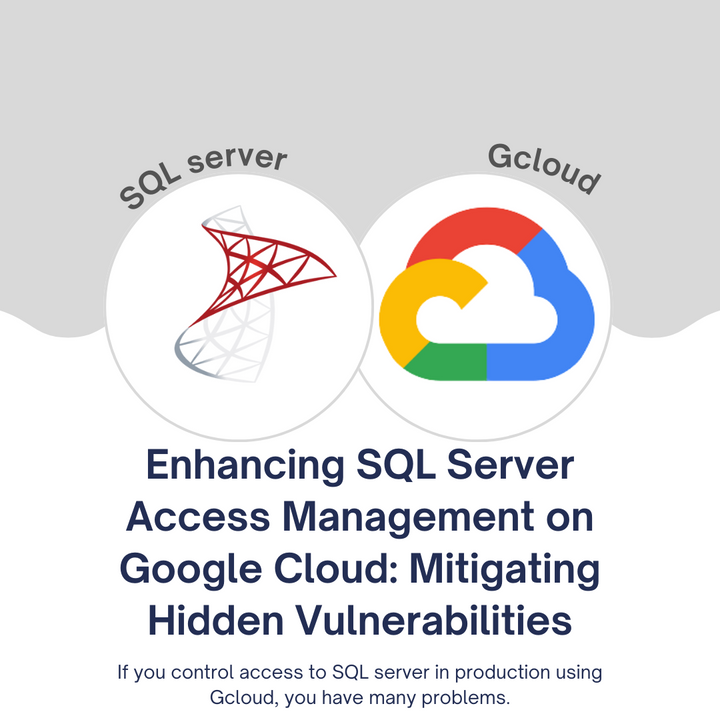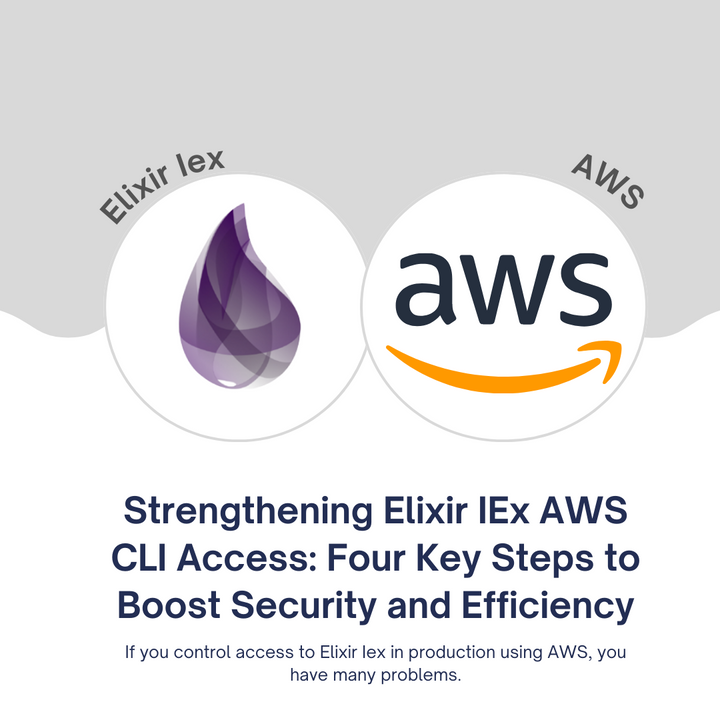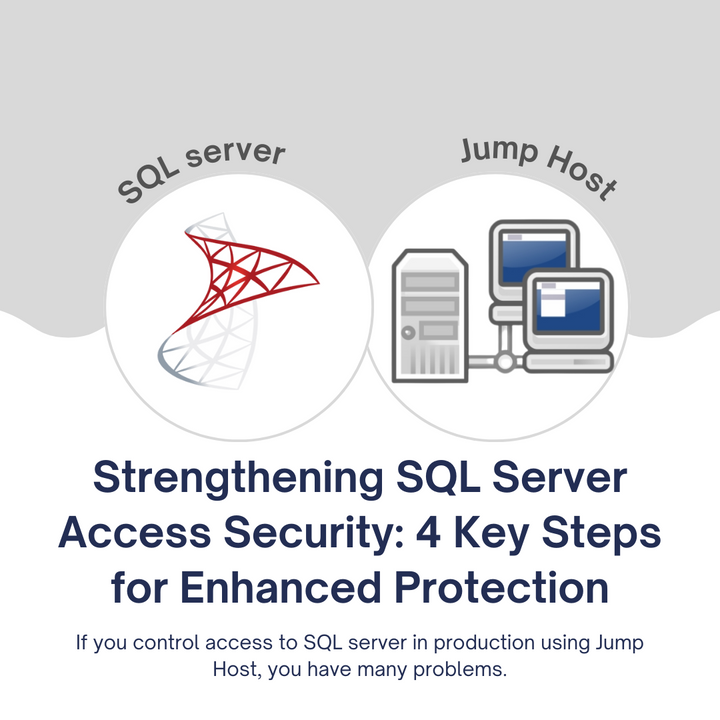8 Benefits of Refined User Roles
The reason most organizations fall victim to data breaches is because they neglect the fundamental principles of database security.
In today's interconnected world, the digital age has brought forth unparalleled convenience, efficiency, and innovation. However, it has also introduced a lurking threat – the vulnerability of data. The reason most organizations fall victim to data breaches is because they neglect the fundamental principles of database security. This happens because many organizations underestimate the importance of comprehensive security measures, leading to data breaches that can be financially and reputationally devastating. In this post, we will show you how to enhance your database security and protect your critical data assets.
In an era where data is the new currency, the security of your databases is paramount. A data breach not only jeopardizes your organization's financial stability but also erodes the trust your customers have in you. The consequences can be dire, both financially and reputationally. But worry not; we have the solutions to fortify your database and shield your organization from potential threats.
We’re going to walk you through:
- Conducting a Comprehensive Data Audit
- Implementing Strong Access Controls
- Regularly Updating and Patching Your Database Software
- Encrypting Sensitive Data
- Training Your Team and Monitoring for Anomalies
Enhancing your database security is not just about preventing data breaches; it's about safeguarding your organization's reputation, customer trust, and financial stability. By following these steps, you'll ensure your databases are resilient against evolving cyber threats and that your sensitive data remains confidential.
Step 1: Conduct a Comprehensive Data Audit
Opener: Before fortifying your database security, you must understand what's at stake.
A comprehensive data audit is the foundation of any robust database security strategy. It helps you identify vulnerabilities and critical data assets within your organization. Without this fundamental knowledge, you cannot effectively protect your data from potential threats.
Why it's important: Conducting a data audit is crucial because it reveals the true value of your data and identifies where it's most vulnerable.
In the digital age, data is an organization's most valuable asset. Data breaches can lead to financial losses, legal complications, and damage to reputation. Conducting a comprehensive data audit is essential to understand the extent of your data and where it's most at risk.
Stat: According to Verizon's 2022 Data Breach Investigations Report, 85% of data breaches result from a lack of awareness about sensitive data locations.
Benefit: By conducting a data audit, you gain insights into your data landscape, allowing you to focus your security efforts on the most critical areas. This, in turn, leads to improved security and regulatory compliance, which can prevent costly breaches.
Mistake: Neglecting this step can lead to missed vulnerabilities, leaving your organization exposed to potential threats.
Data breaches often occur due to unawareness of where sensitive data is stored. Failing to identify and secure these critical assets is a grave mistake, as it exposes an organization to unnecessary risk.
Actionable Tip: Use automated tools to discover and classify sensitive data within your organization. Establish a clear understanding of where sensitive data resides.
The first step is to utilize automated tools to scan and classify data. These tools help you identify sensitive data and categorize it appropriately, so you know what needs protection.
Real-life Example: Imagine a healthcare organization identifying patient records as a crucial asset and safeguarding them meticulously. By understanding the value and location of sensitive data, the organization can prioritize security measures effectively.
In healthcare, patient records contain highly sensitive information. A healthcare organization's data audit would identify these records as critical assets and take steps to secure them.
Takeaway: Knowing your data is the foundation of robust security, and a comprehensive data audit is the first step in achieving it.
The key takeaway here is that understanding your data landscape is fundamental to securing it. Conducting a data audit is not an option; it's a necessity for robust database security.
Step 2: Implement Strong Access Controls
Opener: Controlling who can access your database is the first line of defense.
Implementing strong access controls is essential for preventing unauthorized access to your database. Unauthorized access is one of the most common entry points for data breaches. This step ensures that only authorized personnel can access and modify your data, reducing the risk of data exposure.
Why it's important: Unauthorized access is a common entry point for data breaches, and controlling access is crucial for protecting sensitive information.
Data breaches often occur when unauthorized individuals gain access to your database. Implementing strong access controls is essential to prevent such breaches and safeguard sensitive information.
Stat: IBM's Cost of a Data Breach Report (2022) states that the average cost of a breach is $4.24 million.
Benefit: Implementing strong access controls helps prevent data breaches and protects sensitive information from unauthorized access.
Strong access controls limit access to your data, reducing the risk of data breaches. This is crucial in avoiding the financial and reputational costs associated with data breaches.
Mistake: Overly permissive access settings can expose your data to unauthorized individuals, leading to potential breaches.
On the other hand, if access controls are too permissive, they can lead to unauthorized individuals accessing sensitive data. This is a significant mistake that must be avoided.
Actionable Tip: Enforce the principle of least privilege, granting individuals the minimum access required to perform their job responsibilities.
To implement strong access controls, organizations should adhere to the principle of least privilege, granting individuals only the access required for their specific job roles.
Real-life Example: Restricting HR personnel to HR databases only, avoiding access to financial records, mirrors the principle of least privilege. Just as you wouldn't grant a house guest access to your entire home, you shouldn't grant employees access to data they don't need.
This principle can be illustrated by restricting HR personnel to HR databases, just as you wouldn't provide house guests with keys to your entire home.
Takeaway: Limiting access minimizes security risks and reduces the chance of unauthorized individuals compromising your database.
The key takeaway is that limiting access to authorized personnel is essential for minimizing security risks. Strong access controls are your first line of defense against data breaches.
Step 3: Regularly Update and Patch Your Database Software
Opener: Keeping your database software up to date is crucial for security.
Regularly updating and patching your database software is essential for maintaining a secure database environment. Unpatched software is a common target for hackers, and neglecting updates can leave your database exposed to known vulnerabilities.
Why it's important: Unpatched software is a prime target for hackers, and data breaches can be financially devastating.
Unpatched software leaves your database vulnerable to attacks. Data breaches can result in significant financial losses, and organizations must do everything they can to prevent them.
Stat: According to the National Vulnerability Database, 57% of data breaches in 2021 were due to unpatched vulnerabilities.
This statistic emphasizes the significance of regular software updates and patching. Neglecting this aspect can lead to data breaches that could have been prevented.
Benefit: Regularly updating and patching your database software closes security loopholes and vulnerabilities, reducing the risk of breaches.
Regular updates and patches are critical for closing security loopholes and vulnerabilities that could be exploited by cybercriminals. This significantly reduces the risk of data breaches.
Mistake: Neglecting updates can expose your database to known vulnerabilities, making it an easy target for cybercriminals.
Organizations that neglect to update and patch their database software expose themselves to known vulnerabilities, essentially making it easier for cybercriminals to breach their databases.
Actionable Tip: Establish a routine for applying patches and updates, ensuring that your database software is always up to date.
To ensure your database remains secure, establish a routine for applying patches and updates. Regularly updating your database software should be a standard practice within your organization.
Real-life Example: Updating your smartphone's operating system to protect against the latest security threats is akin to regularly updating your database software. Just as you want your smartphone to be secure, you want your database to be as well.
Updating your smartphone's operating system to protect against the latest security threats is a familiar analogy. Just as you keep your smartphone updated to ensure security, the same applies to your database software.
Takeaway: Regular maintenance safeguards your database and reduces the likelihood of falling victim to known vulnerabilities.
The key takeaway is that regular maintenance, including updates and patches, safeguards your database. By staying updated, you reduce the likelihood of falling victim to known vulnerabilities and potential breaches.
Step 4: Encrypt Sensitive Data
Opener: Data encryption acts as a powerful shield against prying eyes.
Data encryption is a crucial security measure that ensures your data remains confidential, even if unauthorized access occurs. This step protects your sensitive data from being exploited, adding an extra layer of security.
Why it's important: Data encryption secures your data, even if your database is compromised.
Data breaches are not always preventable, but data encryption ensures that even if unauthorized access occurs, the data remains secure and confidential.
Stat: A study by the Ponemon Institute reveals that data breaches cost an average of $3.86 million.
The significant financial cost of data breaches highlights the importance of data encryption as a safeguard against potential losses.
Benefit: Encrypting sensitive data protects it from unauthorized access, even if the database itself is compromised.
Encrypting sensitive data adds an extra layer of protection, ensuring that even if your database is compromised, the data within remains secure.
Mistake: Failing to encrypt sensitive data leaves it vulnerable to unauthorized access and potential data breaches.
Neglecting to encrypt sensitive data is a mistake that can leave your data vulnerable to unauthorized access, potentially leading to data breaches.
Actionable Tip: Use encryption tools like AES for data at rest and SSL/TLS for data in transit to secure sensitive information.
To implement data encryption effectively, use encryption tools like AES for data at rest and SSL/TLS for data in transit. These tools ensure your data remains secure under various circumstances.
Real-life Example: Think of data encryption as sealing a letter in an envelope before sending it through the mail. The envelope ensures the letter's confidentiality, even if it falls into the wrong hands.
An everyday analogy for data encryption is sealing a letter in an envelope before sending it through the mail. The envelope protects the letter's confidentiality, even if it ends up in the wrong hands.
Takeaway: Encryption provides an additional layer of protection, making it difficult for unauthorized parties to access sensitive information.
The key takeaway is that encryption provides an additional layer of protection. It makes it significantly harder for unauthorized parties to access sensitive information, even if they gain access to your database.
Step 5: Train Your Team and Monitor for Anomalies
Opener: Your security measures are only as strong as your team's awareness and vigilance.
Training your team and monitoring for anomalies is essential for ensuring your organization's database security. Employees are a common entry point for data breaches, whether through inadvertent errors or malicious actions. Educated employees and early threat detection are key components of a robust security strategy.
Why it's important: Employees are a common entry point for data breaches, and a well-prepared team can prevent them.
Data breaches often occur due to employees' inadvertent actions or malicious intent. Therefore, educating your team and monitoring for anomalies are crucial steps to prevent breaches.
Stat: The 2022 Cybersecurity Workforce Study reports a global shortage of 4.07 million cybersecurity professionals.
The shortage of cybersecurity professionals emphasizes the importance of training your existing team. With a lack of experts, organizations must equip their employees with the knowledge and skills to protect their databases.
Benefit: Training your team and monitoring for anomalies reduce the risk of data breaches and help maintain the integrity of your database.
A well-prepared team and effective monitoring reduce the risk of data breaches and ensure the database's integrity remains intact.
Mistake: Neglecting to train and monitor can lead to data breaches due to human error or malicious insiders.
Neglecting to train your team and monitor for anomalies can lead to data breaches caused by human error or malicious insiders. It's a critical mistake that organizations must avoid.
Actionable Tip: Conduct regular cybersecurity training sessions for your team and implement intrusion detection systems to monitor for unusual activity.
To enhance database security, organizations should conduct regular cybersecurity training sessions for their employees and implement intrusion detection systems to monitor for unusual activity within their databases.
Real-life Example: Just as you teach your family members to lock doors and windows to prevent break-ins, you should educate your employees on security best practices. Intrusion detection systems act as the "security cameras" for your database, alerting you to suspicious activities.
Educating your team on security best practices is akin to teaching your family members to lock doors and windows to prevent break-ins. Intrusion detection systems function as the "security cameras" for your database, alerting you to suspicious activities.
Takeaway: A well-prepared team and vigilant monitoring are essential for maintaining the security of your database and protecting your organization from data breaches.
The key takeaway is that a well-prepared team and vigilant monitoring are essential components of database security. They play a crucial role in protecting your organization from data breaches and maintaining the integrity of your database.
In conclusion, enhancing your database security is a critical aspect of safeguarding your organization's sensitive information and reputation. By following these five steps, you can create a robust security framework that minimizes the risk of data breaches and ensures the confidentiality and integrity of your data assets. In an increasingly digital world, these measures are essential for any organization looking to protect its most valuable resource - data.



